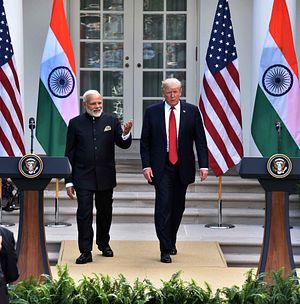Admiral John Michael Richardson, the chief of naval operations of the U.S. Navy, has just wrapped up a visit to India to explore additional areas of naval cooperation between the Indian and U.S. navies. Richardson’s trip provided the opportunity for both sides to deepen their naval collaboration as part of their broader defense ties.
During his visit, Richardson met with a number of Indian officials, including Indian naval chief Admiral Sunil Lanba, who is also chairman of India’s Chiefs of Staff Committee (COSC), as well as Indian Defense Secretary Sanjay Mitra and other senior officials. They are reported to have discussed all issues covering operations and exercises, training interactions, as well as capacity building and enhancement.
The visit comes against the backdrop of U.S. Secretary of State Mike Pompeo’s statements that the United States is reorienting its ties with like-minded partners in nurturing “a free and open order” in the Indo-Pacific. He said that the United States is “banding together with the likeminded nations like Australia, India, Japan, and South Korea to make sure that each Indo-Pacific nation can protect its sovereignty from coercion.”
Like this one, many of the recent initiatives have been in the backdrop of a more muscular China that has been using infrastructure investment and other economic tools to further its narrow interests, even when China understands the economic non-feasibility of these projects.
A particular concern, as Admiral Richardson’s visit shows, is China’s growing naval power, a concern to both India and the United States. The PLA has traditionally been a land-focused force, but this is no more the case. Both the specific need of protecting China’s sea routes of commerce – vital for a nation as dependent on foreign trade as China – and China’s larger ambition to return to its traditional great power role, require China to expand its naval power.
The Chinese naval base in Djibouti established in 2017 is a case in point. It has also established a firmer foothold in the Indian Ocean by acquiring Sri Lanka’s Hambantota part for 99 years. (Interestingly, possibly to demonstrate its control over the port, Sri Lanka held a week-long exercise with the United States known as Cooperation Afloat Readiness and Training (CARAT) in Hambantota). China also has access to Pakistan’s Gwadar port, which adds to its growing maritime footprint.
China’s naval push is leading India and the United States to do a lot more together, especially in the seas. Even though India has been trying to improve relations with China, New Delhi has also stepped up its security engagements with Washington. India’s recent decision to join the United States, Japan, Australia, and the Philippines in sailing through and conducting a naval exercise in the South China Sea demonstrated India’s growing concerns with a belligerent China and the need to cooperate and coordinate with other like-minded partners in the region.
The United States, too, has changed, with the Trump Administration, in particular, taking a much more strategic and longer-term approach to India that is more clearly directed at China. The United States granted the ‘Major Defense Partner’ status to India in 2016 and the ‘Strategic Trade Authorisation-1’ (STA) rank to India in 2018, evidence of the changing view in Washington regarding India’s role in the region. The 2+2 Strategic Dialogue between the two sides also had its inaugural edition in September 2018 and the signing of the Communications, Compatibility, Security Agreement (COMCASA) have added more substance and depth into the defense and strategic cooperation.
The recent U.S. decision to approve the sale of two dozen multi-role MH-60R Seahawk maritime helicopters to India for around $2.6 billion is important in the context of having strengthened anti-submarine warfare capabilities against China. These helicopters can operate from a number of different platforms including frigates, destroyers, cruisers and aircraft carriers and can be used for multiple missions including anti-surface and anti-submarine warfare operations along with secondary missions including vertical replenishment, search and rescue, and communications relay. Other important developments in this respect include the Seahawk helicopters to be armed with Hellfire missiles. These are capable of undertaking multiple missions with anti-submarine warfare missions being a critical one.
The two sides have also strengthened education, training and joint exercises in recent years – the two navies recently concluded a joint submarine-hunting exercise in the Indian Ocean, with the goal of having more reinforced and coordinated maritime patrol and reconnaissance missions in the region. The United States has sold India a number of major non-naval items also, underlining the broader nature of military ties. Earlier, India took possession of four of the 15 Boeing-made Chinook heavy-lift helicopters ordered in 2018. In addition, India has placed orders for 22 Apache attack helicopters from the United States, the first of which was handed over to the Indian Air Force last week.
Richardson’s visit will help in furthering the growing cooperation between the two sides. Because this cooperation is being driven by external pressures that both the United States and India feel, it is likely that it will deepen, irrespective of the outcome of the current national elections in India.

































